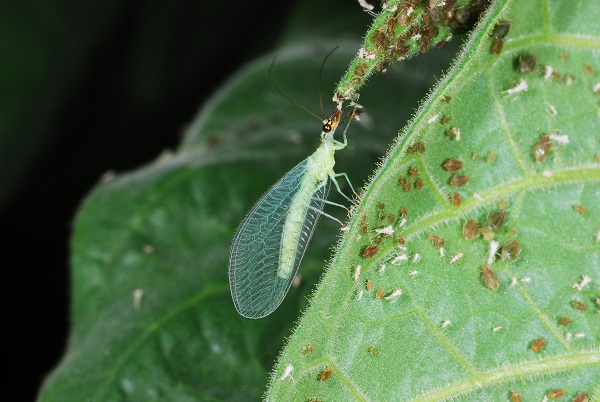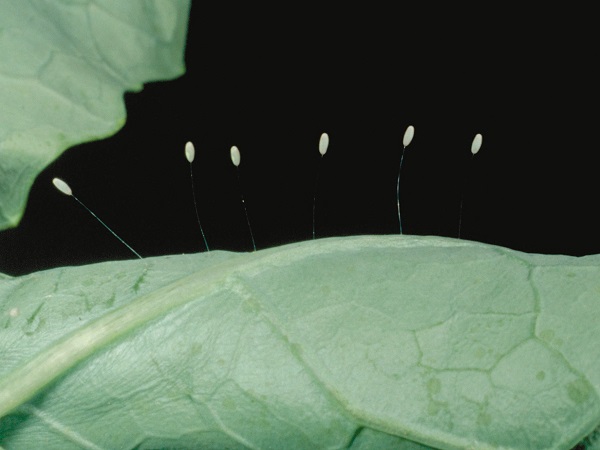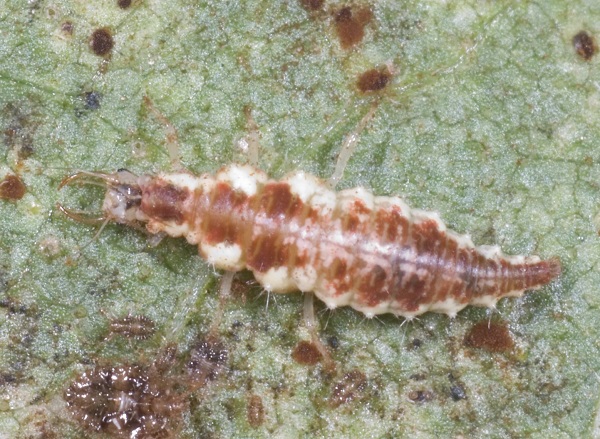Green Lacewing
ENTFACT-708: Green Lacewing | Download PDF
by Ric Bessin, Extension Specialist
University of Kentucky College of Agriculture
Green lacewings are an often under-appreciated group of beneficial insects. As with lady beetles, these natural enemies are important predators of many types of soft bodied insects and insect eggs. These insects are common in the spring summer and fall and their contribution to insect control is immense.

Figure 1. Green lacewings have many cross veins in their wings and golden eyes.
The adult green lacewing is about 3/4 inch long, light green and has a delicate appearance with lacy wings. One unusual characteristic are its eyes, they look like two golden hemispheres. They are weak fliers and are commonly found near aphid colonies. The adults feed mostly on nectar, pollen, and honeydew but with some species the adults will feed on insects.
The eggs are either laid singly or in small groups. Each is always found perched on the tip of a hairlike stalk that is about 1/2 inch long. This helps to reduce cannibalism of the eggs by sibling larvae. Females will usually deposit the egg close a food source for the larvae.

Figure 2. Each eggs is perched on a half-inch hair-like stalk.
The larvae are brown and white and may grow up to about l/2 inch in length. Larvae are called aphidlions, because they feed on other soft-bodied insects as well as aphids. They are voracious feeders, attacking with large, curved, hollow mandibles. This is the most beneficial stage with the lacewings. They feed on soft-bodied insects like aphids, but will also feed on caterpillars and some beetles.

Figure 3. Lacewing larvae have large sickle-shaped mandibles to feed on their prey.
The larvae will pupate on plants which they were searching for insect prey. The pupa is light in color and egg shaped.
While rare, lacewing larvae are known to bite humans. This is usually nothing more than a small skin irritation. Despite these rare encounters, they remain important natural enemies of many insect pests.
Purchasing Lacewings
Green lacewing eggs have been available from a few biological control supply houses in North America. These have been used with some success in Kentucky at controlling aphids in greenhouses and in plant beds. One advantage when using lacewing eggs over lady beetles is that the beetles are winged and will disperse from the release area. When the lacewing larvae hatch, they are wingless and remain in the general area to search for insect prey.
Revised: 8/22
CAUTION! Pesticide recommendations in this publication are registered for use in Kentucky, USA ONLY! The use of some products may not be legal in your state or country. Please check with your local county agent or regulatory official before using any pesticide mentioned in this publication.
Of course, ALWAYS READ AND FOLLOW LABEL DIRECTIONS FOR SAFE USE OF ANY PESTICIDE!
Images: Ric Bessin, University of Kentucky Entomology
